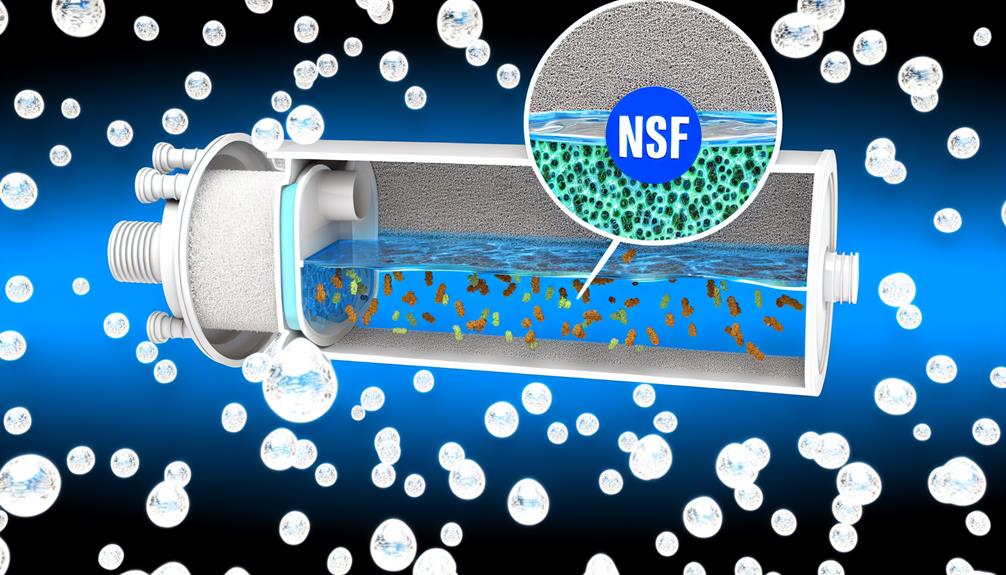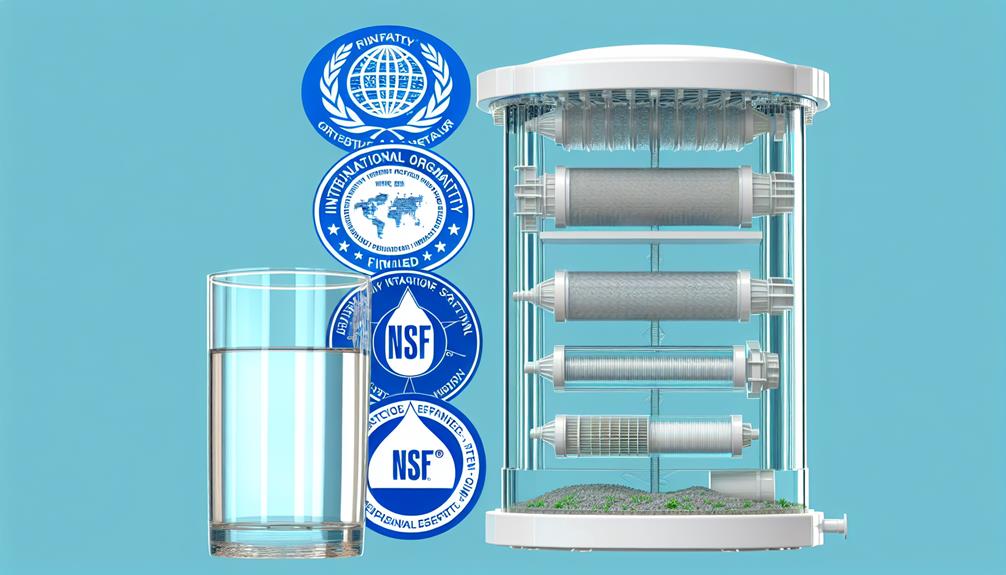Have you ever considered what guarantees the safety of the water pouring from your filter? As you seek to protect your health and your family's, understanding the NSF water filter certification standards becomes a critical aspect of your choice in water filtration systems.
The NSF, recognized globally for its commitment to public health protection, provides a certification process that ensures your water filter meets strict quality and safety criteria. You're likely familiar with the NSF seal, but the nuances of what lies behind it—such as the differences between NSF/ANSI 42, 53, and 401 standards—may not be as clear.
By gaining a deeper insight into these certifications, you equip yourself with the knowledge to make informed decisions about the water you drink. Stay tuned, as we're about to unveil the layers of assurance these standards offer and how they impact the purity of your water.
NSF Certification Overview
Understanding NSF Certification provides assurance that a water filter has met stringent standards for quality, performance, and safety, ensuring your drinking water's protection. The NSF, a global independent organization, is intrinsic to the water treatment industry, offering product testing and certification across 180 countries. This rigorous certification process is founded on a bedrock of scientific testing and standardized protocols, designed to safeguard human health.
When you select NSF-certified drinking water treatment products, you're choosing items that have been scrupulously tested for the reduction of specific contaminants. The standards—such as NSF/ANSI 42, 53, 44, 55, and 58—focus on diverse water treatment methodologies, encompassing aesthetic and health effects, water softening, ultraviolet treatment, and reverse osmosis systems. Each standard addresses a particular aspect of water quality, ensuring that certified products deliver safe drinking water by effectively mitigating potential hazards.
You can identify these certified products through the NSF mark, the Contaminant Reduction Claims Guide, or by searching the NSF online database. This level of transparency and accessibility is pivotal, offering you the necessary tools to verify claims and make informed decisions.
Ultimately, NSF certification is a testament to a product's compliance with established NSF Standards for Water Treatment and a promise of reliability in your quest for safe drinking water.
Water Filter Testing Protocols
To ensure your water filter lives up to its claims, the NSF implements rigorous testing protocols that meticulously assess its ability to reduce specific contaminants. These protocols are central to the Water Filter Certification process, as they provide a measurable standard for filter efficacy in relation to public health and safety.
During the testing phase, your filter undergoes challenge tests that push its capabilities to the limits, including exposure to extreme temperatures and high concentrations of organic matter. This simulation of harsh conditions ensures that the filter maintains performance and integrity when it matters most—during actual use in your drinking water system.
For a deeper level of certification, such as NSF P231, manufacturers voluntarily submit their filters to a grueling 10-day testing regimen. This certification is indicative of a filter's robustness against microbiological contaminants under intensive use scenarios.
The NSF/ANSI certifications, including standards 42, 53, 58, 44, and 55, encompass a diverse spectrum of contaminants and treatment systems, confirming that certified filters meet or exceed established safety requirements. It's crucial to verify the legitimacy of any claims of NSF standard testing, particularly if certification isn't explicitly stated, to ensure the filter you choose is truly safeguarding your drinking water.
NSF/ANSI Standard Classifications
NSF/ANSI standard classifications delineate the capabilities of water treatment products to reduce specific contaminants, ensuring consumer safety and product effectiveness. The NSF Standards for Water Treatment provide a framework by which filters are evaluated. NSF/ANSI 42 focuses on aesthetic improvements like taste and chlorine reduction, while NSF/ANSI 53 targets health-related contaminants, such as lead and the recently spotlighted NSF/ANSI 53 Total PFAS.
When a product is NSF Certified, it means it has undergone rigorous NSF testing and certification processes. The NSF database lists products certified to reduce a range of contaminants, adhering to the strict standards set by the Water Quality Association and the American National Standards Institute (ANSI). For instance, NSF/ANSI 44 certifies water softeners that utilize cation exchange resin effectively.
Additionally, NSF/ANSI 55 certification assures that UV treatment systems are capable of inactivating harmful microorganisms, while NSF/ANSI 58 endorses reverse osmosis systems for their ability to filter substances regulated by Health Canada and the EPA. Each of these certifications substantiates product performance claims, allowing you to trust the contaminant reduction capabilities listed by the manufacturer.
Compliance Verification Process
Building on the foundation of NSF/ANSI standard classifications, the compliance verification process plays a crucial role in ensuring that manufacturers meet the stringent requirements necessary for water filter certification. This meticulous procedure is the backbone that maintains the credibility of the NSF mark on water filter products.
The process begins with a comprehensive inspection of the manufacturing facilities. Here, NSF Can Help by scrutinizing the production protocols to ensure adherence to water treatment standards. Following this, a review of product documentation is conducted, which meticulously checks that the product's design and materials align with the tested to NSF Standards.
Sample testing is a pivotal aspect of the compliance verification process. Your product is certified only after it has been rigorously tested and certified to perform according to specific contaminant reduction claims. This isn't a one-time evaluation; periodic retesting is mandatory to maintain the certification.
The certification demonstrates to you, the consumer, that the product has been thoroughly vetted for both performance and safety. Ultimately, by adhering to the compliance verification process, you're assured that any NSF Standards for Water are met, and the integrity of the NSF-certified water filters you rely on is uncompromised.
Maintenance of Certification Status
Ensuring the longevity of a water filter's performance and safety, manufacturers must continually adhere to NSF's rigorous standards through regular audits and retesting. The process for maintaining certification status is a critical aspect of NSF's oversight of drinking water systems. Once NSF certifies a filter, it doesn't just stop there; the filter is tested regularly to confirm that it continues to meet the established Water Filter Standards.
Your certified water filter's structural integrity, efficiency, and contaminant reduction capabilities must be verified consistently to maintain the stamp of NSF approval. This ongoing scrutiny is vital; it guarantees that water filters uphold the stringent standards for Water Treatment as initially certified. If you're a manufacturer, you'll need to demonstrate unwavering compliance with NSF's protocols, ensuring that your product sustains its certified status over time.
Failure to pass these periodic evaluations can lead to revocation of your NSF certification mark—a mark that symbolizes trust and quality in water filtration. Remember, maintaining certification status isn't just about meeting a benchmark; it's about persisting in the promise of delivering safe, clean drinking water to consumers through your NSF-certified water filters.

